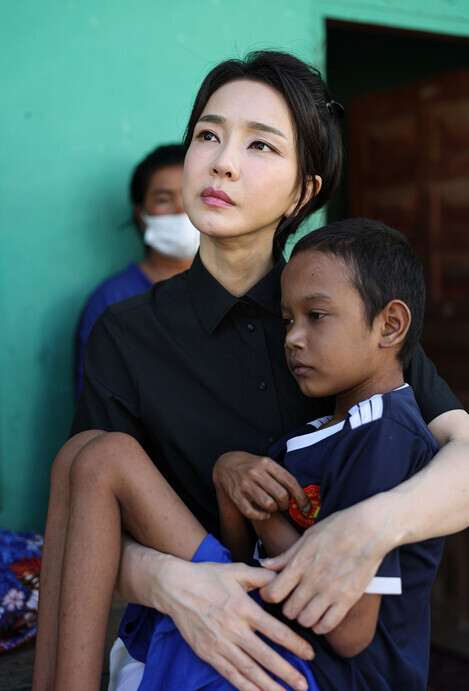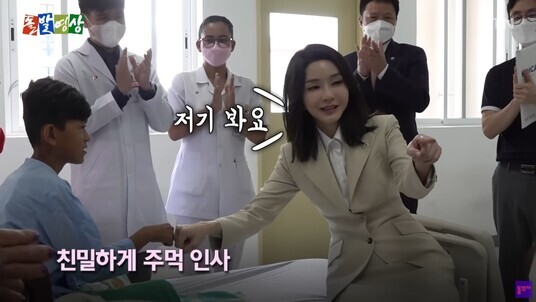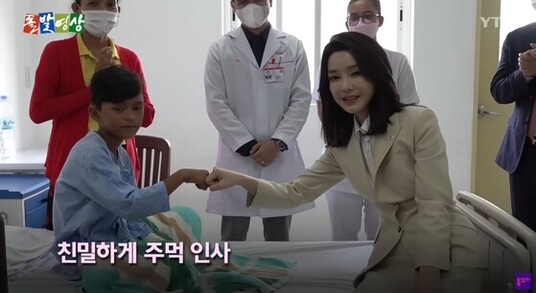hankyoreh
Links to other country sites 다른 나라 사이트 링크
What distinguishes this photo of S. Korea’s first lady from “poverty porn”?

A controversy has arisen over photos of Kim Keon-hee, first lady of South Korea, taken while she visited hospitals for the underprivileged in Cambodia. Kim was accompanying President Yoon Suk-yeol, her husband, on a tour of Southeast Asia.
Jang Kyung-tae, a member of the supreme council of the opposition Democratic Party, criticized the photographs as “poverty porn.” That prompted immediate pushback from the ruling People Power Party (PPP), with floor leader Joo Ho-young objecting that “the expression ‘poverty porn’ is itself degrading and misogynistic.” The ruling party fanned the flames of the controversy by referring Jang to the National Assembly’s special committee on ethics on Wednesday afternoon.
The Hankyoreh examines the main context and the key issues of this controversy below.
Should this be framed as an “uplifting story”?Jang was the first to take issue with the photo shoot. During a meeting of the Democratic Party’s supreme council on Monday, he offered the following criticism of Kim Keon-hee for planning a private event and skipping the program for world leaders’ spouses during Korea’s summit with ASEAN (the Association of Southeast Asian Nations) in Phnom Penh.
“Once again, we’re facing what’s undoubtedly a diplomatic disaster. What amounts to a poverty porn photo shoot by first lady Kim Keon-hee is becoming a scandal,” the Democratic Party lawmaker said.
“Cambodia has been seeking to improve its national image by holding the East Asian summit. In line with that, it asked leaders’ spouses to visit world-famous sites, such as Angkor Wat. But despite the host country’s request, Kim Keon-hee canceled her official plans and took photos at the home of a boy with a congenital heart condition in Phnom Penh.”
“Declining an official request from the country hosting a diplomatic event is a diplomatic discourtesy, and using the sick to promote oneself is an even worse discourtesy.”
On Nov. 11, the first day of Yoon’s visit to Phnom Penh, Kim Keon-hee met with patients and toured the facilities of Preah Ang Duong Hospital and Hebron Medical Center, which is run by Kim Woo-jung, a Korean doctor. The following day, she paid a private visit to the home of a 14-year-old boy suffering from a congenital heart condition.
While at the boy’s house, Kim expressed her hope that he would get well. “You can beat this, right? Let’s meet in Korea once you’re back in good health,” she said.
Kim had meant to meet the boy at Hebron Medical Center the previous day, but his condition prevented him from leaving his home. So instead of visiting Angkor Wat with the other leaders’ spouses, she paid a private visit to his house.
It’s not hard to guess why the Cambodian government would have arranged for the spouses of global leaders to visit Angkor Wat. The Cambodian tourist industry is one of the four key industries buttressing the national economy. In 2019, spending by foreign tourists made up nearly 20% of the gross national product (GNP).
But during the pandemic, the number of foreign tourists fell from 6.61 million in 2019 to 1.3 million in 2020 and then still further to 196,000 in 2021, the Khmer Times reported on June 7.
Cambodia has been actively seeking to bring back tourists since it started reissuing tourist visas this past March, and this international meeting was a good opportunity to promote its cultural heritage.
Some Korean newspapers presented the first lady’s actions as an “uplifting story,” as if she’d skipped out on sightseeing to do some volunteering work for struggling children.
However, one thing we ought to consider is what the Cambodian government wanted to advertise to the world during the summit and what it didn’t want to advertise. That’s why Jang’s remarks about a “diplomatic discourtesy” don’t sound like generic nitpicking.

Considering that the presidential office provided the press with photographs and videos of Kim’s private activities on Nov. 12, they would seem to be fair game for evaluation. The important thing to consider here is that those images are focused on a 14-year-old boy with a heart condition. That serves as the background for Jang’s criticism of “poverty porn.”
In the narrow sense, “poverty porn” refers to photographs or videos that attempt to evoke sympathy by presenting poverty in a sensational way.
“It seems that the appetite for pictures showing bodies in pain is as keen, almost, as the desire for ones that show bodies naked,” Susan Sontag wrote in her book “Regarding the Pain of Others.” Her comparison deftly describes the dark side of humanity that’s conveyed by the term “poverty porn.”
Poverty porn is generally used by relief organizations, whether in Korea or elsewhere, for the purposes of promotion or fundraising.
To be sure, the label of poverty porn doesn’t apply to all visual media that achieve their objective by presenting the unfortunate plight of vulnerable members of society.
The more important yardstick is the attitude and intentions of those seeking to put suffering people in the public record. That means there will always be a fierce debate about whether or not a given image constitutes poverty porn.
A few years ago, the Korea NGO Council for Overseas Development Cooperation (KCOC) published its “Guidelines for the Protection of Children’s Rights in the Media” given a preponderance of controversies about “poverty porn” involving various media and relief organizations.
The document “lays down the principles of media reporting and coverage that all media professionals should abide by in reporting on matters relating to children in developing countries.”
The KCOC is a coalition of over 140 NGOs involved in international relief, development, and humanitarian assistance work.
While it may be argued that there’s no need to go as far as classifying the first lady’s actions or the presidential office’s intentions as “poverty porn,” we can at least judge whether her and the presidential office’s actions adhere to the above-mentioned guidelines.
One of the most important principles emphasized in these guidelines is the “active portrayals of children and their guardians.”
According to the guidelines, children and their guardians should not be portrayed as “powerless and passive recipients of charity, but as active subjects taking initiatives of their own to improve their lives.”
The principle of respecting the privacy of children is also taken very seriously. This goes beyond just asking permission to take a picture or video, but it is also necessary to make sure that the purpose of filming/photographing is sufficiently well explained to the child, that the child and guardian are informed in advance of the dangers involving the materials being used, and it’s also important to make sure there is no excessive number of retakes.
In particular, the guidelines for “portraying impoverished, famished, and/or ill children,” which is arguably the category the first lady’s photos fall under, recommends avoiding portrayals that used images of starving or sick children to elicit pity, as well as advised against using provocative and suggestive images to cause emotional reactions.
The guidelines are intended to educate the media against giving the impression that children and families in developing countries are passively dependent only on aid from developed countries.
The reason why these media guidelines are discussed at length is that the first lady’s photos, for the most part, seem to clash with some of the recommendations stipulated in these guidelines.
One of the photos released by the presidential office shows first lady Kim Keon-hee holding a 14-year-old boy with a sad expression on her face. But if we look at the behind-the-scenes footage posted by YTN of the scene that day, the child actually appears to be sitting comfortably with a relatively bright expression during the filming process. It’s actually the first lady with her dark expression that looks uncomfortable and very unnatural.

Above all, there isn’t a major difference between the composition of the photo of Kim, a healthy adult, holding a sick child and the example of inappropriate portrayal explicitly shown in the guidelines.
Also, when the first lady exchanged a fist bump with a sick child on a hospital bed, she pointed with her finger to the camera for the child to look that way, suggesting she may not have been satisfied with the child’s gaze in the first photograph. She then proceeded to take the picture again.
The first lady requesting a front-facing photo and doing a fist bump greeting twice with a sick child starkly contrasts her own recent demands that her privacy be respected by having her face blurred in the media or making sure the public knew a body double was used to portray her on one particular show. Kim could have done the same to protect the privacy of these children, by, for example, blurring out their faces or taking the photos from a profile angle and not from the front, but she chose not to.
Finally, the “prevention of foreseeable after-production damage and losses” principle of the KCOC guidelines also emphasizes that the media should “foresee all the possible political, social, and cultural ripple effects of their portrayals of children and prevent possible repercussions in advance.”
Political and social controversy has already spread in South Korea over the photos of the first lady’s visit to underserved groups. The damage is feared to be most severe for the 14-year-old boy in Phnom Penh.


Concerning this issue, a community of young activists working on international development cooperation started a signature campaign on Tuesday to denounce the use of “poverty porn” by the first lady and the presidential office. As of Friday, the campaign had gathered about 16,800 signatures out of their goal of 200.
"We condemn the actions of the presidential office and of first lady Kim Keon-hee, who abruptly visited the families of children suffering from heart diseases without any process or plan related to solving the poverty problem, and we define these actions as poverty porn meant to help overcome the government’s crisis,” the group said in a statement of condemnation.
The group also criticized the photo shared by the presidential office of the first lady without a mask visiting the household of a sick child, saying the first lady was the main subject of the picture while adding that she was holding the child in a very unnatural position, as if rocking a newborn baby. According to the youth activists, this photo “created a dark and tragic impression without a context of poverty.”
Although the presidential office’s deputy spokesperson said via a written statement that “sponsorship inquiries started flooding in” after the child’s story became known through the first lady’s photos, the youth activist group says these actions only “portray poverty in a distorted way to stimulate [poverty] fetishism and create the illusion that only external saviors can solve local problems.”
According to the group, the first lady’s visit to the sick children in Cambodia “has all the elements needed to be deemed poverty porn.”
“We would like to ask if Mrs. Kim Keon-hee and the presidential office took any precautionary measures such as reviewing the media guidelines to protect the rights of children and their families during their visit to the sick households in Cambodia,” the group asked.
“We would also like to ask if they have ever considered the efforts of international development cooperation activists who are doing their best at home and around the world while adhering to the 'Do No Harm' principle to create a world where no one is marginalized,” the group added.
By Choi Sung-jin, staff reporter
Please direct questions or comments to [english@hani.co.kr]

Editorial・opinion
![[Column] Life on our Trisolaris [Column] Life on our Trisolaris](https://flexible.img.hani.co.kr/flexible/normal/500/300/imgdb/original/2024/0505/4817148682278544.jpg) [Column] Life on our Trisolaris
[Column] Life on our Trisolaris![[Editorial] Penalties for airing allegations against Korea’s first lady endanger free press [Editorial] Penalties for airing allegations against Korea’s first lady endanger free press](https://flexible.img.hani.co.kr/flexible/normal/500/300/imgdb/original/2024/0502/1817146398095106.jpg) [Editorial] Penalties for airing allegations against Korea’s first lady endanger free press
[Editorial] Penalties for airing allegations against Korea’s first lady endanger free press- [Editorial] Yoon must halt procurement of SM-3 interceptor missiles
- [Guest essay] Maybe Korea’s rapid population decline is an opportunity, not a crisis
- [Column] Can Yoon steer diplomacy with Russia, China back on track?
- [Column] Season 2 of special prosecutor probe may be coming to Korea soon
- [Column] Park Geun-hye déjà vu in Yoon Suk-yeol
- [Editorial] New weight of N. Korea’s nuclear threats makes dialogue all the more urgent
- [Guest essay] The real reason Korea’s new right wants to dub Rhee a founding father
- [Column] ‘Choson’: Is it time we start referring to N. Korea in its own terms?
Most viewed articles
- 160% of young Koreans see no need to have kids after marriage
- 2New sex-ed guidelines forbid teaching about homosexuality
- 3[Column] Life on our Trisolaris
- 4S. Korea discusses participation in defense development with AUKUS alliance
- 5Hybe-Ador dispute shines light on pervasive issues behind K-pop’s tidy facade
- 6Months and months of overdue wages are pushing migrant workers in Korea into debt
- 7[Reporter’s notebook] In Min’s world, she’s the artist — and NewJeans is her art
- 8Presidential office warns of veto in response to opposition passing special counsel probe act
- 9Japan says it’s not pressuring Naver to sell Line, but Korean insiders say otherwise
- 10[Editorial] Penalties for airing allegations against Korea’s first lady endanger free press